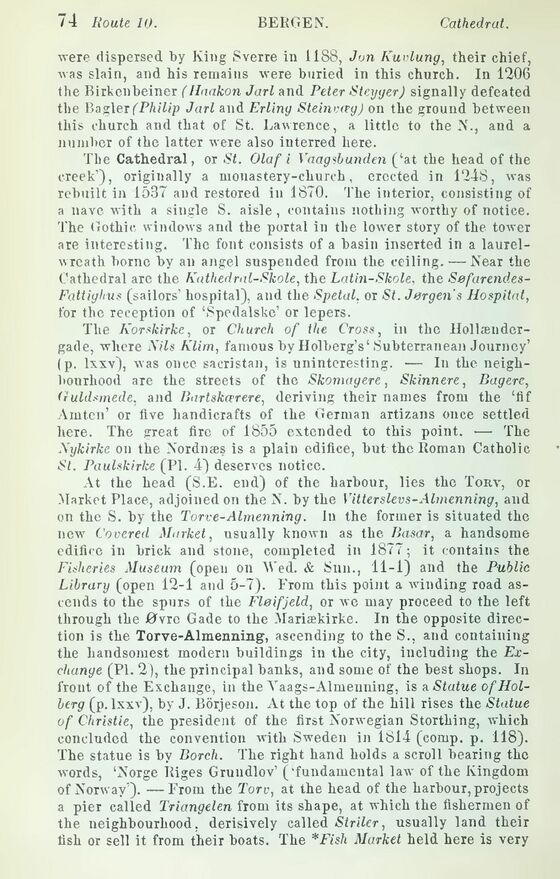
Full resolution (JPEG) - On this page / på denna sida - Norway - Pages ...

<< prev. page << föreg. sida << >> nästa sida >> next page >>
Below is the raw OCR text
from the above scanned image.
Do you see an error? Proofread the page now!
Här nedan syns maskintolkade texten från faksimilbilden ovan.
Ser du något fel? Korrekturläs sidan nu!
This page has never been proofread. / Denna sida har aldrig korrekturlästs.
were dispersed by King Sverre in 1188, Jon Kuvlung, their chief,
was slain, and his remains were buried in this church. In 1206
the Birkenbeiner (Haakon Jarl and Peter Steyger) signally defeated
the Bagler (Philip Jarl and Erling Steinvay) on the ground between
this church and that of St. Lawrence, a little to the N., and a
number of the latter were also interred here.
The Cathedral, or St. Olaf i Vaagsbunden (‘at the head of the
creek’), originally a monastery-church, erected in 1248, was
rebuilt in 1537 and restored in 1870. The interior, consisting of
a nave with a single S. aisle, contains nothing worthy of notice.
The Gothic windows and the portal in the lower story of the tower
are interesting. The font consists of a basin inserted in a
laurel-wreath borne by an angel suspended from the ceiling. — Near the
Cathedral are the Kathedral-Skole, the Latin-Shorn, the
Sefarend.es-Fattiyhiis (sailors’ hospital), and the Spetal, or St. Jergen’s Hospitat,
for the reception of ‘Spedalske’ or lepers.
The Korskirke, or Church of the Cross, in the
Hollænder-gade, where Nils Klim, famous by HolbergV Subterranean Journey’
(p. lxxv), was once sacristan, is uninteresting. — In the
neighbourhood are the streets of the Skomayere, Skinnere, Bagere,
(fuldsmede, and Bartskarere, deriving their names from the ‘fif
Amton’ or five handicrafts of the German artizans once settled
here. The great lire of 1855 extended to this point. •— The
Nykirke on the Nordnæs is a plain edifice, but the Roman Catholic
Nf. Paulskirke (Pl. 1) deserves notice.
At the head (S.E. end) of the harbour, lies the Torv, or
Market Place, adjoined on the N. by the Vitterslevs-Almenning, and
on the S. by the Torve-Almenning. In the former is situated the
new Covered Market, usually known as the Basar, a handsome
edifice in brick and stone, completed in 1877; it contains the
Fisheries Museum (open on M’ed. & Sun., 11-1) and the Public
Library (open 12-1 and 5-7). From this point a winding road
ascends to the spurs of the Fleifjeld, or we may proceed to the left
through the Øvre Gade to the Mariaekirke. In the opposite
direction is the Torve-Almenning, ascending to the S., and containing
the handsomest modern buildings in the city, including the
Exchange (PI. 2), the principal banks, and some of the best shops. In
front of the Exchange, in the Yaags-Almenning, is a Statue of
Holberg (p. lxxv), by J. Börjeson. At the top of the hill rises the Statue
of Christie, the president of the first Norwegian Storthing, which
concluded the convention with Sweden in 1814 (comp. p. 118).
The statue is by Borch. The right hand holds a scroll bearing the
words, ‘Norge Riges Grundlov’ (’fundamental law of the Kingdom
of Norway’). —From the Torv, at the head of the harbour, projects
a pier called Triangelen from its shape, at which the fishermen of
the neighbourhood, derisively called Striler, usually land their
fish or sell it from their boats. The WFish Market held here is very
<< prev. page << föreg. sida << >> nästa sida >> next page >>